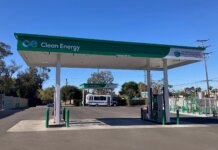California fleets fueled with bio-CNG achieved carbon-negativity last calendar year for the second straight year, Natural Gas Vehicles for America (NGVAmerica) and the Coalition for Renewable Natural Gas (RNG Coalition) report.
Of all on-road fuel used in natural gas vehicles in California in 2021, 98% was renewable natural gas (RNG). According to data from the California Air Resources Board (CARB) the annual average carbon intensity score of bio-CNG in that mix was -44.4 gCO2e/MJ.
Moreover, the carbon intensity of California’s bio-CNG currently remains well below zero. Data from Q1 2022 puts the carbon intensity average of bio-CNG at -61.4 gCO2e/MJ. Q2 2022 data is expected to be released at the end of this month.
“For the second straight year, California fleets fueled with bio-CNG achieved carbon-negativity in their 2021 transportation operations,” states Dan Gage, NGVAmerica’s president. “And since 98 percent of natural gas dispensed in California for use as a motor fuel is from renewable sources, California natural gas vehicle (NGV) fleets consistently achieve a zero-carbon footprint and virtually eliminate criteria pollutant emissions that contribute to asthma, heart disease, and poor air quality.”
In addition to their negative greenhouse gas (GHG) emissions, ultra-low NOx medium- and heavy-duty RNG-fueled trucks and buses perform at levels that are 95% below the federal nitrogen oxide (NOx) standard and 98% below the federal particulate matter (PM 2.5) standard.
“RNG facilities address methane emissions from society’s inevitable waste streams, mitigate the environmental impacts of those emissions and convert captured methane into domestic, renewable, clean fuel and energy,” comments Johannes Escudero, founder and CEO of RNG Coalition. “These numbers highlight the critical role that RNG is playing in decarbonizing the medium- and heavy-duty transportation sectors today.”
Captured above ground from organic material in agricultural, wastewater, landfill or food waste, RNG can produce carbon-negative results when fueling on-road vehicles like short- and long-haul trucks, transit buses, and refuse and recycling collection vehicles.
RNG use as a transportation fuel in California grew 163% over the last five years. NGVAmerica and RNG Coalition report that in 2021 a total of 178.37 million gallons (DGE) of natural gas were used as motor fuel in the state. Of that, 174.28 million gallons (DGE) were from renewable sources.
Data from CARB’s Low Carbon Fuel Standard program confirms that bio-CNG remains the only net-zero carbon motor fuel in California’s alternative motor fuel portfolio, which includes ethanol, biodiesel, renewable diesel, bio-CNG, bio-LNG, electricity, alternative jet fuel and hydrogen.
Aggressive decarbonized transportation goals over the next decade will only be achieved by prioritizing the transition of heavy-polluting, heavy mileage commercial fleets to cost-effective carbon-negative solutions like RNG trucks that are commercially available now, accruing and compounding significant clean air and carbon reductions today.







